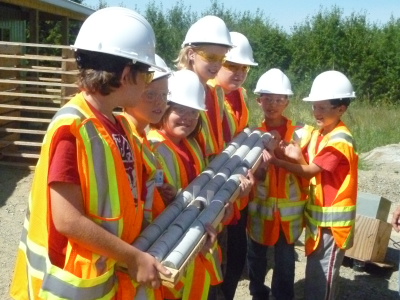What's old is new again.
For decades, the Rainy River district in northwestern Ontario had no operating mines even though the Fort Frances area held a rich legacy of gold mining dating back to the mid-1800s.
With 27 past-producing mines on the books, more than half of Ontario's gold production came from here between 1890 and 1910.
Small wonder as gold prices have shot up that the district has become an exploration hot bed.
Now a new generation is learning all over again what the mining industry is about.
“It's a forgotten industry for a lot of people here because pulp and paper, and logging have ruled the economic paradigm here for several decades,” said Kyle Stanfield, director of environmental sustainability with Rainy River Resources.
His company is advancing toward production of its flagship Rainy River Gold project, located in Chapple Township, 65 km northeast of Fort Frances.
Part of the company's outreach is teaching the locals how the mining cycle works.
“We have to start helping the public understand what mining is all about, because it's fairly new to the district. There hasn't been much mining for 50 years other than the old Steep Rock iron mine in Atikokan.”
Last year, the company held a Mining Matters workshop, run through the Prospectors and Developers Association of Canada, which attracted 45 kids, teens and adults. In August, Stanfield was expecting 70.
PDAC educators arrive for classroom sessions at Confederation College's Fort Frances campus, before the company takes them out to view the company's drill rigs and about 700 km of core amassed since 2004.
Stanfield said many attending last year's workshops were fascinated by the detective work that goes on to find a gold deposit. The participants are walked through the various stages of the cycle from grassroots discovery, to environmental assessment, permitting and eventual mine construction.
Many are surprised that a myriad of functions are remote-controlled, computer-based, leading-edge high-tech, and are much safer than decades ago.
“I think people are blown away by the science behind it,” said Stanfield. “They see this is not a brute force exercise. There is programming involved and modelling with all kinds of computer graphics work.”
The underlying message is to wake people up to the idea that industries like mining help sustain our high-quality way of life.
“You see the lights go on in people's eyes,” said Stanfield.
“Most people have no clue where all this material that runs our daily life comes from. We just take it for granted. And gold is very good value on the bullion side for economic security, but it's also used in electronics, MRIs and the space program.”
Stanfield hopes it sparks young people to pursue careers in engineering or geology.
Tannis Drysdale, economic development officer with the Rainy River Future Development Corporation, said the business community has certainly caught the mining bug as companies like Rainy River Resources, Bayfield Ventures and Coventry Resources ramp up their projects.
“We've had businesses start up to service them and it's been a transition for some surplus labour and equipment that's been involved in the forestry industry.”
Though optimistic that mines will eventually open, Drysdale said the town of Fort Frances prefers being cautious in planning for any massive influx of labour, at least until the miners give development the green light.
“It would be awkward if we were moving to open a subdivision because a mine is opening when that hasn't happened yet.”
In Chapple Township, closer to the exploration activity, that municipality is launching a study for industrial and residential opportunities should a mine open.
“It makes good sense to be prepared,” said Drysdale.
Stanfield said local supplies and companies are regularly coming into their local office in Emo and the corporate office in Thunder Bay.
“We're working with them to understand what we're going to be needing in different phases; everything from core boxes and stakes, to highly-machined parts for mills.”
There's also interest from manufacturers and fabricators to the south in Minnesota and Wisconsin.
About 30 resumés filter into the office each week from tradespeople looking to transfer their skills from forestry to mining.
“We have a lot of great people willing to work for us and happy to come on with us when we get this built,” said Stanfield.
Vincent Sheppard, mayor of Emo Township, said finding space for people to build homes shouldn't be a problem.
The municipality of 1,000 has 70 residential lots on its west side and 28 estate lots to the north, but the township's water and sewer capacity is maxed out. Emo is applying for government funds for an $11-million lagoon and water treatment plant.
“With mining, it's hard to say just what's going to happen, but we do need water and sewer anyway whether they come or not,” said Sheppard.
He said the area has always been attractive for mineral exploration, but has shown little by way of promising results. Gold prices have brought the drill rigs back.
“It should be good if everything goes as everyone is hoping.”




